When she was tiny, Genevieve Williamson used to play with her imaginary friends, Jibby and Juna. It is the perfect name for her polymer clay jewellery. “In my mind they still epitomize childhood, freedom, imagination and most importantly, play.”
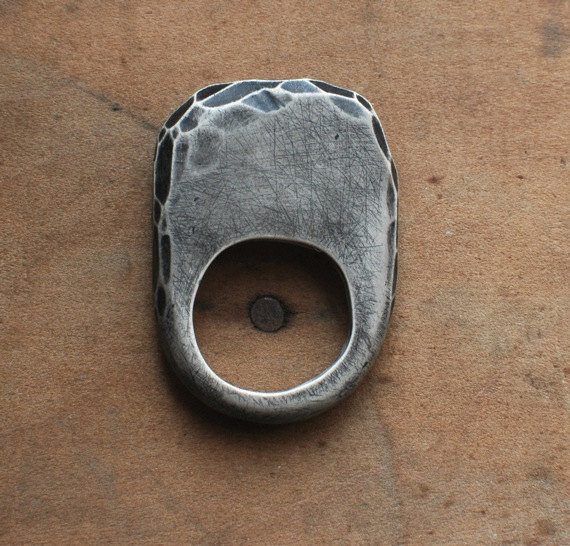
jibby and juna – fragment ring in ivory
Originally studying art at university with a concentration in crafts and metal, she came to polymer quite by accident in 2007. “Someone gifted me all of their old supplies – all the basics, everything to get me started. I had trained as a metal smith but didn’t have space for a studio at the time and found that polymer wonderfully filled a creative niche for me. I 2008 I opened my Etsy shop.”
Experience with ceramics, wood and textiles during her time as a craft major, in addition to her metal experience, has all fed into her work now: “Some bit of knowledge from each of these disciplines can be applied to polymer clay.”
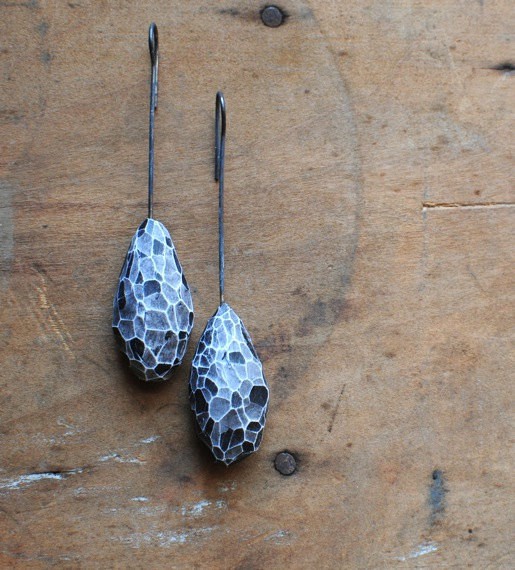
jibby and juna – fragment drop earrings in black and white
“Inspiration can come from anywhere, or maybe I should say everywhere. Despite the simplicity of a lot of my work, to me it feels like a combination of things I’ve seen or heard or learned coming together as visual ideas. I do a lot general sketching, just shapes, forms, lines, just sort of thinking with a pencil. Then I play around with clay, I form and cut shapes, I add texture. I make components and let them sit on my work table so I can manipulate them and play with them until I figure out what my next step toward a completed piece will be.”
“I love that quote by Picasso,
‘Inspiration exists but it has to find us working.’ “
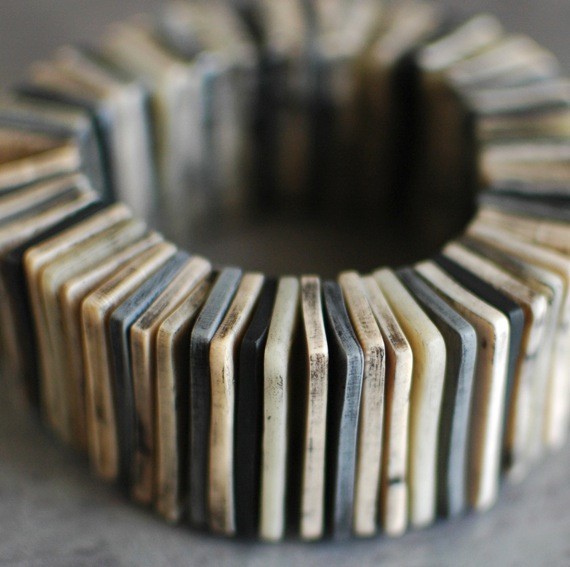
jibby and juna – sediment 1 bracelet
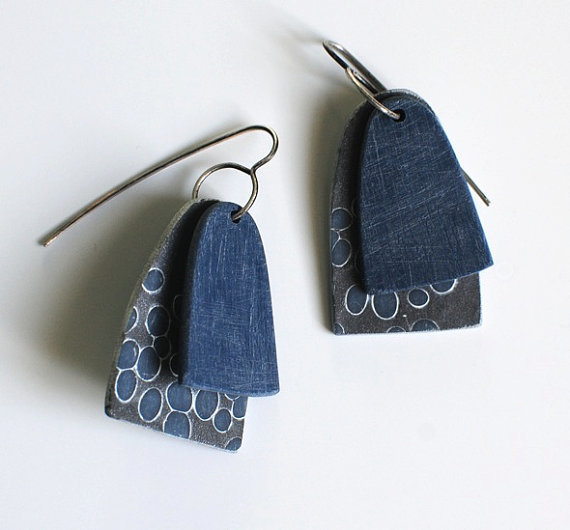
jibby and juna – bubble earrings in inky blue
She has always been inspired by great art. Her father was a high school art teacher and painter so she was taken to galleries and museums often.”I have very early memories of some specific artists…Alexander Calder, Henri Matisse, Paul Klee, Miro.
“My Mom said I once stood in front of a Mondrian and did a little jig. I must have only been about three. She said I told her the shapes made me happy.”
“What interests me has expanded as I’ve gotten older but I’m still really drawn to strong graphics, bold shapes and asymmetric design.”
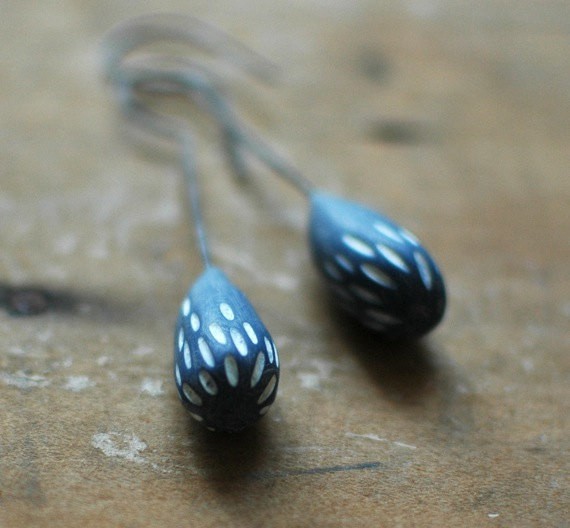
jibby and juna – The Tide earrings in blue
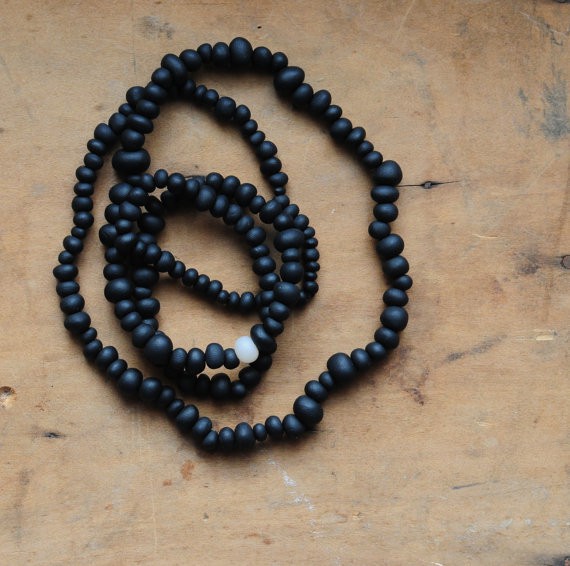
jibby and juna – black sheep necklace
After almost six years with her business, Genevieve’s worst experience happened quite early on. “One of my earliest pieces of jewelry broke soon after the customer got it in the mail. She sent me photos but I couldn’t tell if she did something to it intentionally or if the error was mine. She wouldn’t send the piece back for me to examine but I refunded her money anyway and then I threw myself into learning more baking/curing process for polymer. I purchased a probe thermometer with a timer and my husband and I ran tests on at least 6 different ovens. The experience was really upsetting but it taught me to pay very strict attention to the curing process.”
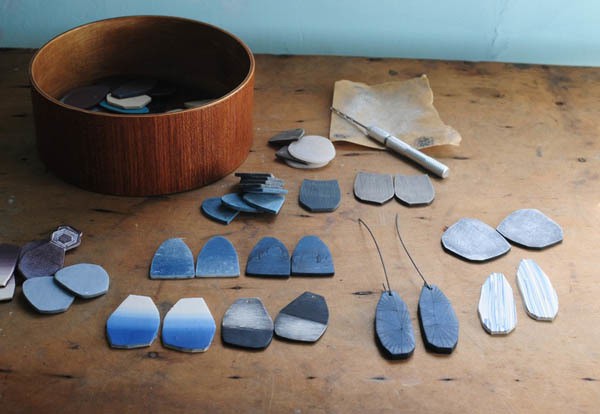
jibby and juna – on the workbench
“The best piece of advice I’ve ever gotten was to carefully observe. I clearly remember my Dad telling me when I was learning to draw from observation that I should be looking more at the thing I was drawing than at my own drawing. Its good advice for drawing and good advice for life. Pay attention, look for detail, really strive to see what’s there and don’t be overly consumed with yourself.”
*
You can find more of Jibby and Juna in their Etsy shop, jibbyandjuna, and on Genevieve’s own site, genevievewilliamson.com (which includes her blog, full of luscious photos.)

That’s a really interesting style – I’d never seen polymer clay jewelry quite like this! I love it. I actually had my first ‘bad’ experience as a polymer clay jewelry consumer earlier this fall – I was the one who had a piece break on me! It actually came with a note that it was delicate and not to touch it too much, so I pretty much blamed myself and thought I’d glue it back together at some point (it wouldn’t look too bad, I don’t think, since the pendant was sort of a flower cluster and it separated evenly) but I do wonder if that shouldn’t have happened. I’ve found I can be a bit too easy on fellow handmade sellers.
Thanks Lix, that’s a really interesting story, and I for one am absolutely adamant that makers should strive for the highest quality in craftsmanship at all times. I reckon if it’s jewellery, it should be made to be more robust rather than less – otherwise, what’s the point if you can’t wear it?
Thanks for your interest in my work Lix! I think the unknown quality of polymer is the issue – for craftsman and for buyers because in truth, its still a very new material. Buyers don’t really know what to expect from a piece made of polymer and new craftsman may not fully understand the baking or curing process.
Thats what my problem was with a piece that failed early on. A piece must be held at a certain temperature for a specific amount of time (based on thickness) for the malleable component (the chemical that makes it flexible, that makes it a clay) to be rendered inert. If that isn’t done, it might seem finished but at some point in time the piece will weaken and break. I hope that makes sense!
I’m sorry you had a negative experience with a piece of polymer jewelry. I can’t know for sure of course but it sounds like it was not cured properly.
You should be able to treat a piece of polymer jewelry pretty much the same as a metal piece of jewelry , if not rougher to be honest. (I “test” pieces by dropping them, flinging them against a wall – no kidding – because I realize that the viability of the material is still really in question for a lot of people.) However I think many of us have also purchased jewelry made of traditional materials thats broken too. So its all about the craftsmanship.
I hope you’ll try a piece of polymer jewelry someday if you find something you love 🙂
thanks for the insight Genevieve, and I absolutely agree that craftsmanship MUST be of the highest standard, or so much else is lost – for both the maker and user. Both come away less than satisfied.